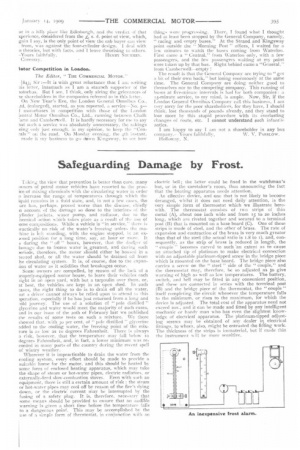Safeguarding Damage by Frost.
Page 19

If you've noticed an error in this article please click here to report it so we can fix it.
Taking.the view that prevention is better than care, many rwners ot petrol motor vehicles have resorted to the pracice of mixing chemicals with the circulating water in order
O increase the range of temperatures through which the iquid remains in a fluid state, and, in not a few cases, the ure has, perhaps. proved worse than the disease, chiefly
o account of the damage so done to the interiors of the ylinder jackets, water pump, and radiator, due to the hemical action winch takes place as a result of dm use of ome compositiona. While a vehicle is in service,there is tractically no risk of the water's freezing unless the mathine is left standing, with the engine stopped, in an exxrsed position for a long time, say, an hour or more. It s during the " off " hours, however, that the dar-kur of iamage due to frozen water is greatest, and during such )criods, therefore, the motor should either be housed in a lea ted shed, or all the water should be drained oil from he circulating system. It is, of course, due to the expan;ion of water as it solidifies that breakages occur.
Sonic owners are compelled, by reason of the lack of a )roperlyeequipped motor house, to leave their vehicles each -light in an open yard, with but a tarpaulin over them, or, at -best, the vehicles are kept in an open shed, In such ::ases., the right thing to do is to drain oil all the water, mt a driver cannot always be relied upon to attend io this Iperation, especially if he has just returned from a long and :old journey. The use of a solution of " pale distilled" ,;rlyeerine and water would meet the majority of such cases, and in our issue of the 20th of February last we published the results of some tests on such a mixture. We there showed that with 30 per cent. of '' pale distilled " glycerine added to the cooling water, the freezing point of the mixture is as low as to degrees Fahrenheit, There is always a risk, however, that the temperature may fall below to degrees Fahrenheit, and, in fact, a lower minimum was recorded in many parts of the country during the recent spell of wintry weather.
Wherever it is impracticable to drain the water from the cooling system, every effort should be made to provide a suitable borne for the motor, and this should be heated by some form of enclosed heating apparatus, which may take the shape of steam or hot-water pipes, electric radiators, or externally-fired slow-combustion stoves. Even with such an equipment, there is still a certain amount of risk : the strain or hot-water pipes may cool off by reason of the fire's dying down, or the electric current may be interrupted by the fusing of a safety plug. It is, therefore, necessary that some means should be provided to ensure that an audible warning is given a short time before the temperature falls to a dangerous point. This may be accomplished by the use of a simple form of thermostat, in conjunction with an electrir bell; the latter could be fixed in the watchman's hut, or in the caretaker's room, thus announcing the fact that the heating apparatus needs attention.
An effective device, and one that is not likely to become deranged, whilst it does not need daily attention, is the very simple form of thermostat which we illustrate herewith. The thermostat consists of two strips of thin metal (A), about one inch wide and from 15 to 20 inches long, which are riveted together and 'secured to a terminal post (B) that is mounted on a base board (C). One of these strips is made of steel, and the other of brass. The rate of expansion and contraction of the brass is very much greater than that of the steel (the actual ratio is 1.8 to t), and, consequently, as the strip of brass is reduced in length, the "
couple " becomes curved to such an extent as to cause an attached tip of platinum to make electrical connection with an adjustable platinum-tipped screw in the bridge piece which is mounted on the base board. The bridge piece also carries a screw on the " steel " side of the " couple," and the thermostat may, therefore, be so adjusted as to give warning of high as well as low temperatures. The battery, switch, and hell may be fitted in any convenient position, and these are connected in series with the terminal post (13) and the bridge piece of the thermostat, the " couple " itself completing the circuit whenever the temperature falls to the minimum, or rises to the maximum, for which the device is adjusted. The total cost of the apparatus need not exceed 20S„ and it can be made and fitted by any intelligent mechanic or handy man who has even the slightest knowledge of electrical apparatus. The platinum-tipped adjusting screws may he obtained of any dealer in, electrical fittings, to whom, also, might be entrusted the fitting work. The thickness of the strips is immaterial, but if made thin the instrumen will be more sensitive.






















